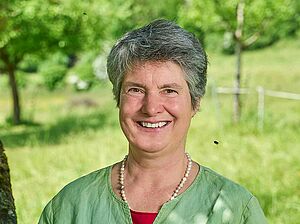"Valuable opportunities for collaboration"
50th anniversary voices

Gertrud Häseli is an organic farmer and politician and has worked with FiBL on a number of occasions. She is close to FiBL both in terms of ideals and location; her home in Wittnau is only a few kilometres away from FiBL in Frick.
What do you remember most about your collaboration with FiBL?
Because I live close to FiBL, I have had valuable opportunities for collaboration. One particularly exciting project was SME Organics, an international project in which an organic action plan was drawn up for various regions in Europe, including Aargau, our canton. The international exchange with trips to France and Italy to organic farms in Grande Aquitaine and Lombardy were very rewarding. Agriculture, nutrition, processing, marketing – in this project I recognised Europe as innovative in the organic sector. A very good basis for further work was created with the cantonal organic action plan. Unfortunately, there are major stumbling blocks for its implementation in the canton of Aargau. Traditional farming concepts are still predominant in vocational training and on farms.
What other connections do you have with FiBL in your work?
As an organic farmer and politician, I can have my feet on the ground and my head free to think and act. Every day I can bring my practical experience into politics and society: Promoting organic farming, cooking regionally and seasonally, reducing meat, making care work visible. FiBL's scientific findings help me in my political work on organic farming issues, and as an organic farmer I value FiBL's knowledge transfer into practice.
What do you think has changed at FiBL?
The premises of the agricultural school in Frick, founded in 1954, with the women farmers' school added in 1984, were taken over by the diamond in the rough, FiBL, in 1994. While many were still weary at first, it has become a respected institute for research and extension and a very valuable meeting place with charisma. My favourite places at FiBL are the old immovable fountain from 1954 made of shell-bearing limestone from Mägenwil and the new fountain, a cast sculpture over which water flows, thus changing it over time with, for example, growing moss and algae.
When you look to the future, what are your wishes for FiBL?
My wish for FiBL is that in the future it will be recognised at a cantonal and a national level as equal to universities and other research institutions. The canton of Aargau should provide FiBL with the same financial resources as the High-Tech Centre Aargau. Food and agriculture are our livelihoods; we must give these sectors the value they deserve.



